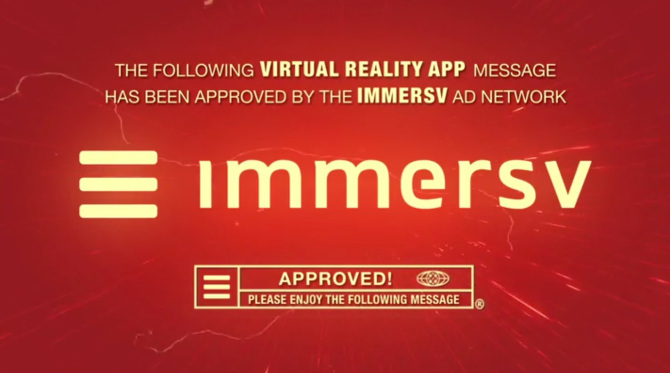You don’t necessarily need an expensive headset to enjoy some of what virtual reality has to offer. The power to enter an all-new world is in your pocket, using smartphones in devices like the Samsung Gear VR or Google Cardboard. Then it will be a matter of finding great content.
With that content comes advertising opportunities, which is where the newly announced Immersv platform comes in. Immersv is a virtual reality ad platform that allows “VR developers to drive both distribution and monetization for their content,” according to the official announcement. Not only does it deliver advertising from within a virtual reality space, but it is a VR experience in itself.
Mihir Shah, co-founder and CEO of Immersv, states, “Our goal is to build a marketplace to help consumers discover great VR apps and experiences, and to empower all the artists, content producers and game publishers building VR content to turn their hard work and creativity into commercial success.” Immersv seems to be on the right path, since its beta tests show that the completion rate for its videos were at 79 percent, with some trailers reaching as high as 88 percent. In comparison, video ad completion rates averaged 46 percent on smartphones and 54 percent on tablets, according to a Vindico report.
Developers that include Archiact, Element Games, Lunagames, Alitech, Arloopa and Meta3D have already signed on with the ad platform.

Shah speaks to [a]listdaily about Immersv’s capabilities and how it will lead the way to advertising in virtual space.
What is Immersv, and what can it do?
Immersv is a mobile virtual reality advertising platform. Our goal is to drive the mobile VR market to mass consumer adoption by helping VR developers turn their content into successful businesses. We provide both distribution and monetization for VR apps and content by providing a virtual reality ad unit that easily plugs into any VR app. It also provides a great way for consumers to discover new VR content by watching video trailers within VR settings.
Can you give an example of how Immersv can be best put to use?
Basically, any VR developer that has an app in the marketplace can use Immersv to drive downloads. All they have to do is create a video trailer, and our system can show that trailer within our fully customizable VR ad units, which are presented to consumers within other VR apps. The ad units are full VR experiences themselves and provide a great way for consumers to experience and discover new VR content. But it’s not just about distribution. We can help VR developers generate significant revenue as well, basically by getting paid by other VR apps to run their ads.
Can Immersv be used within VR video content in addition to games? What about livestreaming VR events?
Yes, absolutely. The Immersv platform can be used by any VR content developers, not just game developers. We have publishers ranging from media companies and retailers to movie studios and other types of entertainment.
Your beta testing shows very high completion rates for Immersv videos compared to those viewed on smartphones and tablets. What do you think is the reason for such a big difference?
The main reason is that the ad experience is so vibrant and compelling. It’s a great way for consumers to experience great new VR content, and it gets them excited to go and download it. It goes to show just how hungry consumers are for fresh new VR content, and that this is a great way for them to discover it.
There is such a wide variety of VR experiences, with more to come. Will Immersv be able to fit into every situation?
Yes, our platform was built from the ground up for the VR environment, and to be extremely flexible and customizable so that it can fit just about any situation. Our ad units have already been integrated into apps in a number of unique ways, and we are just seeing the tip of the iceberg in terms of is adaptability.
How soon do you think we’ll see mass adoption of VR?
It’s already starting to happen. I think we’ll look back at 2016 as the year that VR really took off, with Mobile VR as the main adoption driver. We are very excited to see the tremendous strides made by Google and Oculus, and we think this is just the beginning.

